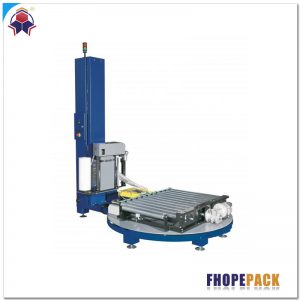
A tray that automatically stretches the wrapper from the line, and the input to the packaging area is automatic, based on the control system Settings. When completed, a tray is delivered to the end of the line, and a new tray is automatically transferred to the wrap area.
Operators, by contrast, loading and unloading machine is semi-automatic stretch packaging needs to be done, wrap cycle also needs to be started, and also need to be adjusted, the appropriate allows the load to effective packaging can be ensured.
First, fpc9 packaging.
In the simplest form, a tray is placed on a rotating disk, while the movie delivery system distributes the stretch film on the load. The place where the movie delivery system starts is usually from the bottom of the load, which is then wrapped to the top, and then rolled back to the bottom.
The most common type of stretching wrapper is the fpc9 wrapper, which can be configured to use a variety of applications effectively.
Second, fpc8 packaging.
It’s not like when the turntable machine spins, the state of the load stays still, and the system around the load is the movie delivery system. Unstable, light, heavy loads can be handled by these types of wrappers, which can be packaged from low to high.
Third, fpc7 packaging.
A fpc7 wrapper wraps a tray on a pallet, usually in the process of moving the conveyor through the machine. People usually use them to make, smooth or bulky goods such as doors, pipes, carpet rolls, coffins, etc.
Fourth, fpc6 packaging.
These fpc6 are high-speed wrappers that can handle very large loads per hour and can be as many as 200 loads. The industries they often appear in are paper towels, tissues and drinks. The highly specialized machine is fpc6, which USES only a small proportion of stretched packaging today.
Operators, by contrast, loading and unloading machine is semi-automatic stretch packaging needs to be done, wrap cycle also needs to be started, and also need to be adjusted, the appropriate allows the load to effective packaging can be ensured.
First, fpc9 packaging.
In the simplest form, a tray is placed on a rotating disk, while the movie delivery system distributes the stretch film on the load. The place where the movie delivery system starts is usually from the bottom of the load, which is then wrapped to the top, and then rolled back to the bottom.
The most common type of stretching wrapper is the fpc9 wrapper, which can be configured to use a variety of applications effectively.
Second, fpc8 packaging.
It’s not like when the turntable machine spins, the state of the load stays still, and the system around the load is the movie delivery system. Unstable, light, heavy loads can be handled by these types of wrappers, which can be packaged from low to high.
Third, fpc7 packaging.
A fpc7 wrapper wraps a tray on a pallet, usually in the process of moving the conveyor through the machine. People usually use them to make, smooth or bulky goods such as doors, pipes, carpet rolls, coffins, etc.
Fourth, fpc6 packaging.
These fpc6 are high-speed wrappers that can handle very large loads per hour and can be as many as 200 loads. The industries they often appear in are paper towels, tissues and drinks. The highly specialized machine is fpc6, which USES only a small proportion of stretched packaging today.